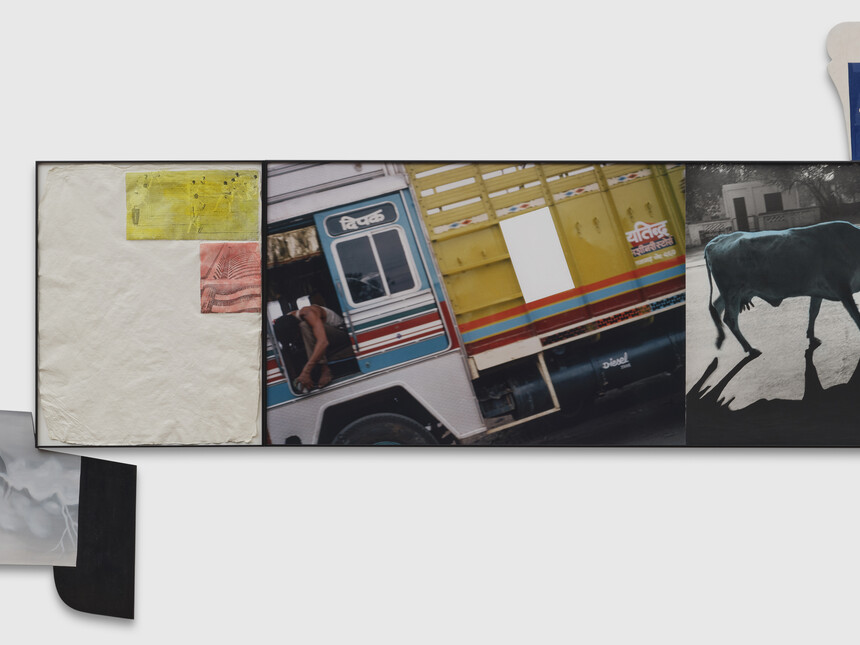
05 Sep Ahmedabad 1992
Source Credit: Content and images from Wall Street International Magazine by . Read the original article - https://www.meer.com/en/82546-ahmedabad-1992

Throughout John Baldessari’s prolific and impactful career, he consistently examined
and defied the expectations that influence our perception of art. His unique
methodology in the realms of painting, photography, source materials, and text
redefined and challenged conventional art historical limitations, making him a pioneer
of American Conceptualism. Drawing from a wide range of sources—advertising, film
culture, Marcel Duchamp, and Ludwig Wittgenstein—he created absurdist, complex
yet accessible juxtapositions. Monika Sprüth and Philomene Magers are pleased to
present the second iteration of Ahmedabad 1992, a solo exhibition of an alluring series
of mixed media assemblages Baldessari produced during his residency in India. For
the first time in decades, a selection from this unique period in the artist’s oeuvre was
initially shown during summer 2024 at the London gallery. Introducing the body of
work to Berlin viewers, Ahmedabad 1992 will travel to the gallery’s German space for
Berlin Art Week. An accompanying catalogue with contributions by Shanay Jhaveri
and Mario d’Souza will be published to mark the occasion.
In the early weeks of 1992, Baldessari was invited to live and work in the expansive
compound of the Sarabhai family, Indian industrialists and patrons of the arts, in the
Shahibaug district of Ahmedabad. Members of the prominent family formally set up
the residency in the 1970s, but the Sarabhais were interacting with artists, designers
and architects long beforehand. Like many patrons and cultural protagonists of postindependence India, they actively engaged with foreign artists and established
international networks, hoping to restrain revivalist currents and promote a new vision
for the country. Following several other established artists, among them his close
friend Lynda Benglis, Baldessari resided in the Villa Sarabhai, a red brick and concrete
open-plan house designed by Le Corbusier in the 1950s.
The rarely seen multi-panelled works that stem from Baldessari’s stay are a direct
response to his new surroundings, which were inspiring and overwhelming in equal
measure and had a lasting impact on the artist’s oeuvre. The collages are composed
of his own photographs, some enhanced by paint; an eclectic mix of found imagery;
rubber mudflaps painted by local sign painters; Formica pieces modelled after parts of
local motorised rickshaws; and printed handmade paper collected from the Gandhi
ashram in Ahmedabad. Immersing himself in Indian culture, the Californian
photographed the bustling city at a time when India was subject to radical changes due to the emergence of new technologies, globalisation processes, and an influx of
Westerners.
The cleverly devised arrangements of Ahmedabad 1992 document this shift. Here,
floating electronics in a futuristic cyberspace point towards the burgeoning
technological revolution of the ’90s. There, a sense of motion and transition is
reflected in the dominant motifs, including modes of transportation (motorbikes,
bicycles, trucks), animals in movement (a cow trotting along the roadside or a bird in
flight), and cricket being played or kites being flown. Also at constant play in the series
is the alternating and interlacing of looking and being looked at, with several images
either observing the action of street scenes or featuring a subject’s direct gaze, and
sometimes both.
Cornerstone aspects of Baldessari’s practice, like the mining of pre-existing imagery,
fell on fertile ground in a place as visually spectacular as India. Images from magazines
and the everyday are deconstructed and reassembled to stress their original
ambiguity or curiousness. Figures are painted over, withdrawing the underlying
information and complicating the reading of the image. Expanding on this sort of
erasure, Baldessari produced the Removal series (1995) shortly thereafter. Also
employed in the present works is the use of dots to cover faces, a predominant
feature of the artist’s work from the mid-1980s onward, which simultaneously draws
the eye to the point of obfuscation and redirects the viewer towards other parts of the
image. The resulting works, which Baldessari produced after his return to Santa
Monica, expand beyond the sum of their parts and evoke the atmosphere and
complexity of Indian scenery through associative juxtaposition.
The artist’s signature wry humour gives way to a surprisingly raw view of everyday
settings. Entered into new contexts, they are recoded and refuse immediate answers,
allowing viewers to generate their own responses. The residency provided him with a
unique opportunity to not only observe a new environment, which in many ways
contrasted his Los Angeles milieu, but also permitted him to turn a critical lens inward
for a period of self-reflection. It is the works’ contingent quality—with each element
modifying the next—Baldessari’s vibrant use of colour, and the keen eye of an outsider
that render the Ahmedabad series an intimate commentary on what it means to look
during a moment of reinvention.
John Baldessari (1931–2020) lived and worked in Venice, California. Selected solo
exhibitions include Fundación Malba–Museo de Arte Latinoamericano de Buenos Aires
(2024), Moderna Museet, Stockholm (2020), Laguna Art Museum, Laguna Beach
(2019), Museo Jumex, Mexico City (2017), Städel Museum, Frankfurt (2015), Garage
Center for Contemporary Culture, Moscow (2013), Fondazione Prada, Milan (2010),
Stedelijk Museum, Amsterdam (2011) and Tate Modern, London (2009), which traveled
to Museum of Contemporary Art, Barcelona (2010), Los Angeles County Museum of
Art (2010), and Metropolitan Museum of Art, New York (2010–2011). Selected group
exhibitions include the 53rd Venice Biennale (2009) at which he was honored with the
Golden Lion for Lifetime Achievement, Whitney Biennial (2009, 1983), Documenta VII
(1982), Documenta V (1972) and the Carnegie International (1985–86).
Source Credit: Content and images from Wall Street International Magazine by . Read the original article - https://www.meer.com/en/82546-ahmedabad-1992

